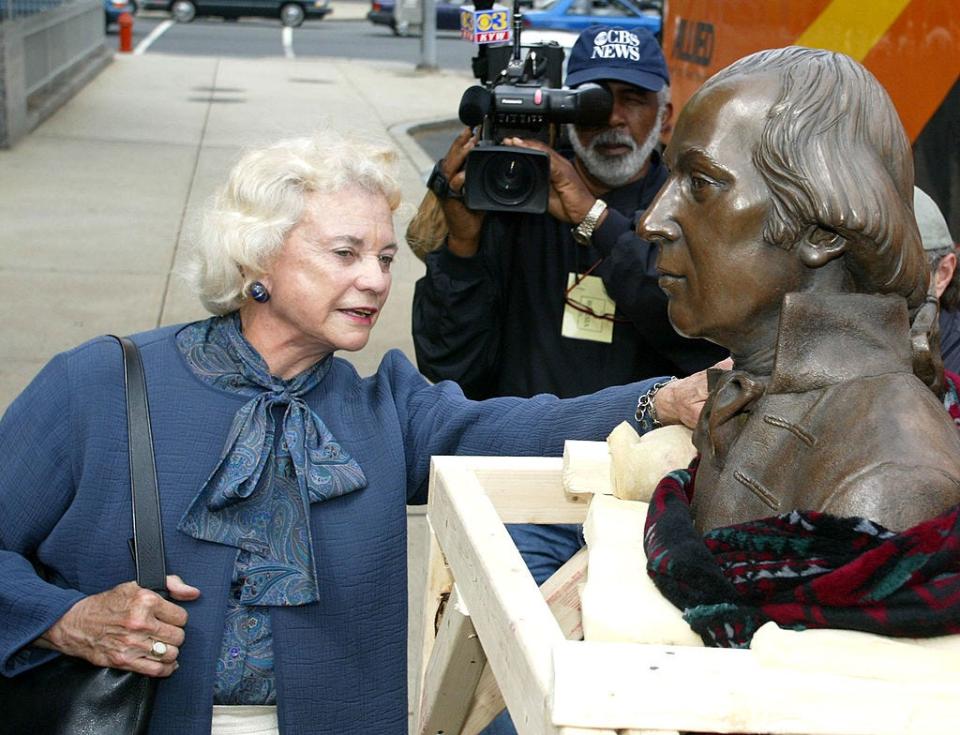Sandra Day O'Connor upset the left and right, but remained the adult in the middle
The United States Supreme Court is a place of majesty and marbled columns built to project a national seriousness about our laws and institutions.
That it would find its first woman justice in one of the most remote places in the country — the dust-driven ranchlands of the Arizona-New Mexico border — tells you something about America.
From that physically demanding environment, came a girl who before age 10 was already building fences and riding herd.
Her first classrooms were not the finishing schools of Exeter and New Haven, but the Lazy B Ranch in the Arizona desert. It made her tough and lean and hard-headed.
It prepared her to do what no other woman had done before.
A top graduate, but she worked without pay
The first female justice of the United States Supreme Court was going to have to push through manifold professional and political obstacles before she could even begin to contemplate the High Court.
Sandra Day O’Connor would take her calloused hands to Stanford University and later Stanford Law, where she would graduate third in her class.
Today that would make her a tier-one candidate for the nation’s top law firms, but in the 1950s, those doors were mostly closed to women.
The law firms wanted women as secretaries.
Instead, O’Connor went to the San Mateo, Calif., county attorney and offered to work without pay as a lawyer, The Arizona Republic’s Ronald J. Hansen recounted.
The county attorney agreed and when he finally had the budget, he began to compensate her.
O'Connor knew how to battle and have fun
From there, it was back to Arizona with her husband and former Stanford classmate, John Jay O’Connor III, and a stint in the Arizona Senate. In politics, she won the respect of colleagues, who later made her the first woman in the nation to gain the title of Senate majority leader.
It was the 1970s and her drive for excellence was well established. Burton Barr, the powerful majority leader of the Arizona House, once famously quipped, “With Sandra, there ain’t no Miller time.”
But that wasn’t exactly true.
Yes, O’Connor would wear her armor in political combat, but she also had her fun side.
Former Phoenix Mayor John Driggs, who was close friends with the O’Connors, would often recall her wit and charm in personal settings.
His son, Adam Driggs, now a Maricopa County Superior Court judge, remembered as a boy salivating for the Mexican meals she would cook for friends and work colleagues.
Driggs recounts: How O'Connor met her destiny on a houseboat
She was delightful and disciplined and self-restrained, but if you pushed her, she would push back.
When one of her male colleagues in the Senate once barked at her, “If you were a man, I’d punch you in the nose,” she replied, “If you were a man, you could.”
She found consensus behind the scenes
She seldom revealed that side of herself. She was always the adult in the room. A born leader who worked quietly for consensus behind the scenes.
In 1979, Arizona Gov. Bruce Babbitt would appoint her to the Arizona Court of Appeals where she would eventually attract the attention of President Ronald Reagan.
Reagan announced in 1981 that he was nominating O’Connor to fill the retiring Potter Stewart’s seat on the High Court. She was confirmed by unanimous vote in the Senate.
What O'Connor knew: About politics that America forgot
The U.S. Supreme Court often finds itself in tension between court originalists who hew closely to the old texts and activists who believe the court must more assertively give direction when legislatures have not.
O’Connor found herself in the middle of that dispute, not lashing herself to any strict judicial philosophy, but approaching the law in the full context of our times and our society.
Why O'Connor was often the swing vote

In a closely divided court, that made her the swing vote, often the most powerful vote on the court and one of the most powerful people in the world.
If you had to define O’Connor’s judicial philosophy, she approached cases with an eye to discretion, not disruption. The Supreme Court was there to guide lower courts and our wider society, not to shake their rafters.
The best examples of that were her refusal to overturn Roe v. Wade and legalized abortion, while allowing legislatures to regulate the procedure.
She might have been the vote that ended affirmative action in university admissions, but instead was the swing vote that allowed colleges to continue considering race.
She did so, however, warning that such laws would eventually become obsolete.
“We expect that 25 years from now, the use of racial preferences will no longer be necessary,” she wrote.
Arizona should be proud of this icon
As the first woman on the court, O’Connor was sharply scrutinized. She could upset the left and the right because she was never eager to stamp hard the court’s imprimatur on the law.
She was respected as a person of grace and intellect, who had achieved much in her life.
When America was ready, those achievements prepared her to break through the brass doors of the Supreme Court and end the all-male tradition of the bench.
There’s a reason The Arizona Republic named Sandra Day O’Connor its 2003 Arizonan of the Year and in 2009, its Arizonan of the Decade.
She will long be an icon to American women and an inspiration to generations of girls not yet born.
But she speaks to all Americans as someone who came of age far from the power center of American decision-making, and used all her personal gifts to rise to one of its highest peaks.
This is an opinion of The Arizona Republic's editorial board.
This article originally appeared on Arizona Republic: Sandra Day O'Connor will be an icon to women for years

